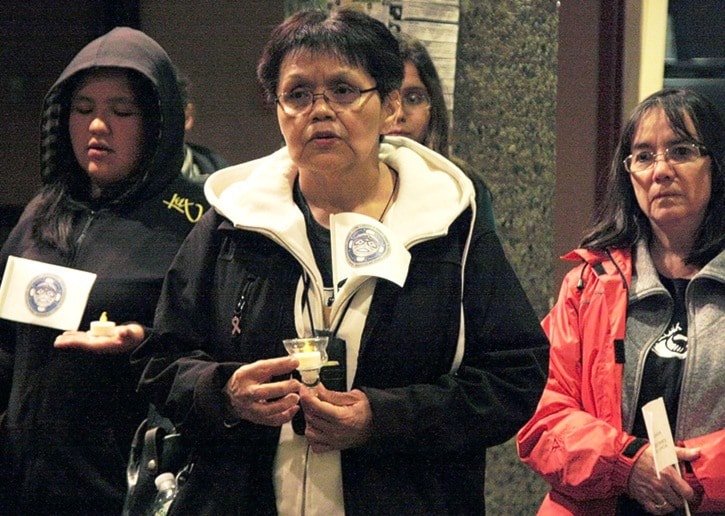People in Prince Rupert, the last stop along the Highway of Tears, marched and remembered the missing and murdered women found along Highway 16 on Friday.
The North Coast Transition Society (NCTS) and Native Women’s Association of Canada held Take Back the Highway Walk and Sisters in Spirit Vigil on Oct. 4, where people walked from the Prince Rupert courthouse to the Lester Centre of the Arts for a candlelight vigil.
Christine White of the NCTS said the event was held to raise awareness.
“We don’t want to become complicit and let things fall into the background. We want governments to hold to the things they said they’d do and carry through with those things,” White said.
Many walkers wore numbers, representing the women who went missing or were found deceased along the Highway of Tears. The victims were mainly of aboriginal descent.
“Prince Rupert is the last stop on the Highway of Tears, where so many of our women have gone missing. There are conflicting numbers around how many women are victims of the Highway of Tears ... what we know is that every women missing is one too many,” White said, adding cell service along the highway would go a long way in helping women.
The vigil at the Lester Centre included a number of speakers, including Jennifer Rice, MLA of the North Coast, who told the Northern View she recently experienced a scare along Highway 16. Rice accidentally locked herself out of her vehicle at a rest stop, where there was no cell service.
“All I could think about was the women along the Highway of Tears, and how that could’ve easily been me. I’m definitely in favour of getting cell service between Prince Rupert and Prince George,” she said, adding she would like to see the federal government do a national inquiry on the issue of missing women.
During Rice’s first question period in July, she asked B.C. Justice Minister Suzanne Anton why a safer transportation option hasn’t been implemented on Highway 16, despite the fact the 2006 Highway of Tears Symposium and the 2012 Missing Women Inquiry report both called for one.
While the event was held in honour of the Highway of Tears victims, it also revolved around the issue of violence against women in general, calling on action to be taken to end the problem and to not blame victims.
Treena Decker, NCTS Stopping the Violence counsellor, shared her story about losing her friend Marne. Marne and her friends went out to the bar one night, but because she was underage she couldn’t get in.
“She said she was fine, and would catch a ride home. She never got home ... she was found months later,” she said.
Decker reminded people not to lay the responsibility of violence against women on the victims, but against the perpetrator.
“There’s a tendency for people to blame the victim. We heard a lot of ‘Why was she standing outside of the bar alone? Why didn’t she call a cab or her parents?’ ... the reality is, regardless of the choice she made, no one had the right to do the kinds of things he did to her and leave her body out in the woods,” Decker said, adding her friend didn’t get the chance to live the rest of her life.
A number of people who attended the vigil signed a Native Women’s Association of Canada federal petition for a national inquiry, something that the Transition Society and MLA Rice would like to see occur.
